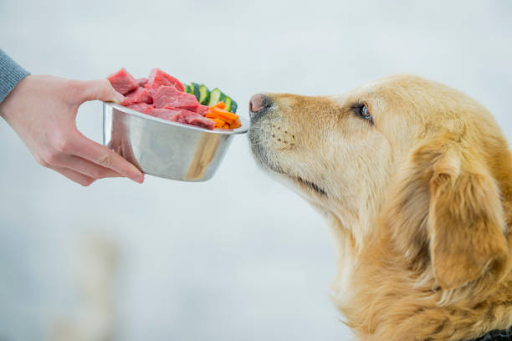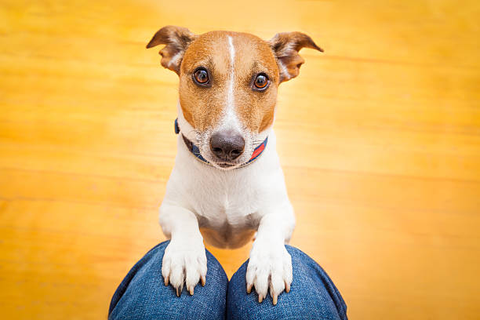
How Many Calories Are in Dog Food?
It takes considerably more than just picking up the first bag of kibble you see at the supermarket to meet your dog’s daily nutritional needs. Always be mindful of the caloric amount of the commercial dry food or wet food formula you choose for your dog.
How Many Calories Are In Dog Food?
So how many calories are in dog food? It depends on whether it’s dry or wet food. Dry dog food typically contains around 97 calories per ounce. In comparison, the caloric content of wet food is only about 25 per ounce.
Why does dry food have more calories than wet food? This is primarily due to the deficiency of moisture in dry food. Dry food often contains 10- 12% water. In contrast, wet food has 74% to 82% water.
All this information is usually displayed on the food package label. The Food and Drug Administration (FDA) requires dog food brands to indicate eight pieces of information on all pet food packaging:
- Brand name
- Weight of the item, net
- Manufacturer’s name and address
- Guaranteed analysis
- Ingredients list
- Animals the food is intended for (e.g., dog or cat)
- Statement of adequate nutrition
- Recommendations for feeding
Calories in pet food can also change depending on the brand and variant. For example, puppies need more nutrients and calories compared to adult dogs because they are growing rapidly. Thus, puppy food is typically more calorie-dense than adult dog food. Working dogs have higher energy demands than your average pet, so they get food with more calories to meet their bodies’ needs.
Reading the Packaging Label
It’s essential to know how many calories your dog’s food contains to determine its daily feeding amounts and ensure your pet eats enough for its stage of life. Some dog food manufacturers do list the number of calories in each package (if not, check their official website), and it may look something like this:
Calorie Content: 3,557 kcal ME/kg; 353 kcal ME/cup
This indicates that one standard measuring cup of said dry food has 353 calories and that one kilogram of it has 3,557 calories (kilocalories of metabolizable [usable] energy). Suppose your 20-pound dog needs between 325–400 calories per day, a cup of this dog food per day would suffice.
Canned dog foods don’t always provide feeding guidelines in cups. Consult the back label of the canned dog food to determine how many calories it contains. For example, one 12.7-ounce can of a well-known wet dog food brand contains 399 kcal. According to the manufacturer’s feeding guide, you should feed your dog 2 cans of this dog food to make it get the right amount calories and nutrients it needs.
Different dog brands have different calorie contents. One brand or variant may contain fewer calories per can or cup compared to another brand or variant. Make a habit of checking the feeding guidelines before giving the food to your dog.
Wait, What is Kcal?
Calories can be “small” or “large” calories. The prefix kilo in the term kilocalorie was intended to point to the large calorie. So a kilocalorie means a large calorie. The term small calorie is hardly ever used, except in chemistry and physics research. As a result, kcal and calories are used interchangeably by many.
In a nutshell, a kilocalorie or kcal equals 1,000 calories. Kcal is a unit of measurement used to express an animal’s daily energy requirement or the caloric density of pet foods. However, many dog food manufacturers use kcal and calories interchangeably. If you read 10 calories on the pet food label, it doesn’t mean 10,000 kcal but 10 kcal.
How Many Calories Should My Dog Have Daily?
Of course, the answer to that depends on various factors, including the size, breed, age, and activity level, and whether the dog is spayed or neutered.
The Association for Pet Obesity Prevention provides approximate daily caloric needs for average indoor pets:
|
Weight |
Caloric Needs |
|
10 lb |
200–275 kcal |
|
20 lb |
325–400 kcal |
|
50 lb |
700–900 kcal |
|
70 lb |
900–1050 kcal |
|
90 lb |
1100–1350 kcal |
The World Small Animal Veterinary Association also provides a more detailed calorie guide for an average healthy adult dog in ideal body condition.
Based on these guides, a 35-pound, moderately active pet needs roughly 670–840 calories daily to maintain its nutrition. A more active dog will need more calories, depending on the work it does. Don’t forget to consider treats in the equation. Treats should only account for 10% of your pet’s daily caloric needs.
Older dogs also require fewer calories, more protein, less sodium, fewer carbs, and important health components, such as prebiotics or probiotics to keep a balanced population of bacteria in their intestines, omega-3 fatty acids, glucosamine for joint health support, and other antioxidants to reduce inflammation.
The guides above are just estimates. Different dogs will also have different nutritional needs. It’s always best to consult your veterinarian to determine the most accurate calorie count your pet needs.
Quality of Dog Food
Keep in mind that food quality is equally essential as calorie count. Even if you calculated the calories precisely, your pet still wouldn’t benefit if you serve it an unbalanced diet without other essential nutrients, such as calcium, phosphorus, zinc, and other vitamins and minerals.
While most commercial dog brand foods are designed to meet at least the basic nutritional demands of dogs, it’s vital to remember that no two dogs have the same nutritional requirements.
They require a variety of nutrients in various amounts throughout their lifespan. A puppy’s dietary requirements differ from an adult’s, just as a large breed’s nutritional requirements will vary from a small breed’s.
If you want to feed your pet a high-quality diet, fresh dog food is one option. A Pup Above makes fresh dog food using human-grade ingredients, non-GMO vegetables, and superfoods. You can choose from different protein options—beef, chicken, pork, and turkey—cooked using the sous vide method to preserve their taste and nutritional value.
Final Thoughts
Even though you think your dog is a carnivore, they also need fruits, grains, and vegetables, just like we do for a well-balanced diet. Strawberries, blueberries, and apples (excluding seeds as they contain cyanide that’s highly toxic to dogs) can make for great low-calorie treats.
If you’re unsure what to feed your four-legged buddy, consult your veterinarian to check whether the dog food you are giving your pet is the proper kind.
Top Stories

Why Do Dogs Lick Their Paws?

Why Do Dogs Whimper & Make Noises in Their Sleep?

Healthy Vet-Approved Homemade Dog Food Recipes

How To Cook Sweet Potatoes for Dogs






















